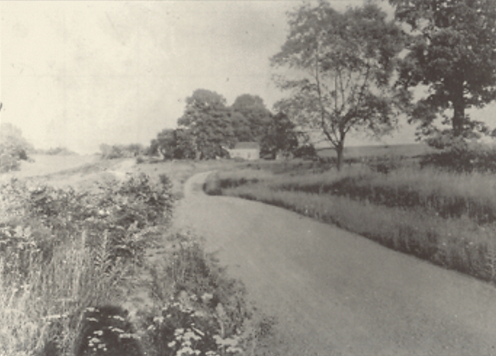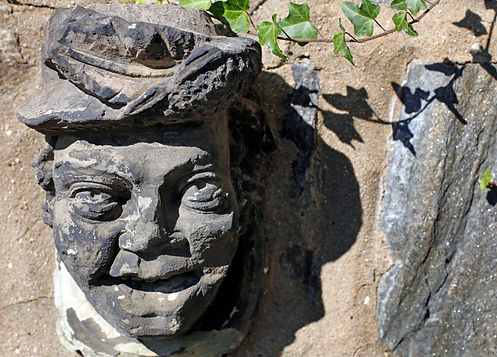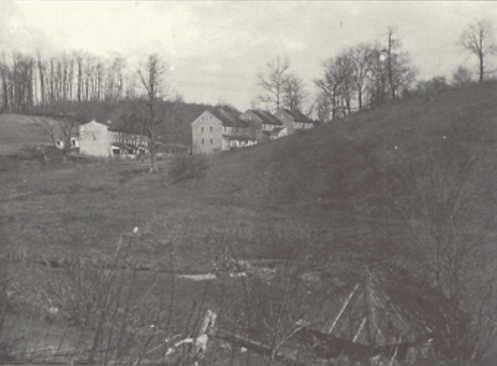
Rose Valley History
Rose Valley was included in land grants by William Penn in 1681 to three Vernon brothers - Thomas, Robert and Randal - while they were still in England. They all arrived here the following year. Robert's grant was confirmed by patent in 1684, Thomas's in 1702 and Randal's in 1711. The three brothers' lands were contiguous, and each had considerable frontage on the east side of Ridley Creek. Randal Vernon built his home on what is now Rabbit Run, and that home still stands. The part of Rose Valley we know as Todmorden was also part of Randal Vernon's grant, but it was not until 1831 when Samuel Bancroft bought the farm and mill on that site that the house was called Todmorden - a name which is said to mean "Death of the Fox" or "End of the Hunt." Robert Vernon's home may have been the three-story stone house on Old Mill Lane, now known as the Bishop White House, getting that name from William White who sent his family here from Philadelphia during an epidemic of yellow fever in 1793.
The power of Ridley Creek was harnessed in 1789 when Nicholas Stimmel built his snuff mill where the Old Mill now stands. After snuff went out of fashion, the mill was used to grind bark to make fever medicine and then converted to a paper mill. The mill stood unused and deserted for a decade until Antrim Osborne bought it in 1861 to manufacture woolens. To provide housing for his many workers, Osborne built twelve six-room houses, six in a continuous row on the east side of Rose Valley Road, and three double houses across the street. The houses were completed in 1870 and they still stand. At the peak of his wool business, in 1879, Osborne bought Hutton's mill, now Hedgerow Theatre. Osborne died in 1890.
The era that makes Rose Valley unique among the Philadelphia suburbs is that of the Arts and Crafts movement. Generally defined as the English revival of decorative arts, it was one aspect of a many-sided reaction against the Industrial Revolution and the diminished role of the craftsman in the production of goods. The principal leader of the reaction was William Morris whose ideas crossed the Atlantic and made their appeal to those interested in social and philosophical concepts. One of those interested was William Lightfoot Price, a successful Philadelphia architect and a man in love with people and ideas.
In 1901, Will Price bought eighty acres in the name of the Rose Valley Association from the bankrupt estate of Antrim Osborne. With the financial backing of a group of wealthy liberal Philadelphians interested in social reform, Price set about creating the Arts and Crafts movement's vision of "the art that is life." The Rose Valley Association was to be an association of shops whose purpose was the manufacture of handcrafted items. The Association would rent space to these shops and work that met the standards of the Association would be stamped with the Rose Valley seal, a wild rose superimposed by a 'V' and circled by a buckled belt to symbolize fellowship. On the social side, true to his democratic philosophy, Price envisioned a community where "the tiniest cottages may be built side by side with a more spacious neighbor."
From the beginning, the Association was plagued by financial problems, and it must be said that although many beautiful items were crafted here in those early years, the commercial aspect of the Arts and Crafts experiment was not a success. In the first five years, only three shops had been established, and of these, only the furniture shop had any real organization. By the end of the decade, the Rose Valley Association had been forced to sell most of its assets to pay its debts.
Although the commercial side of the experiment was not a success, the social and artistic sides were. From its beginning Rose Valley was attractive to people who saw an opportunity to use their creative talents in their living environment. The Rose Valley Folk, initially organized to deal with the practical problems of self-government, became more a social organization. The Folk organized all sorts of community events - picnics, swimming and canoeing parties, baseball games. At night the Guild Hall was kept in perpetual use with concerts, plays and dances. The community threw itself into these productions, writing the plays, designing sets, making costumes, printing programs and acting.
Today, the memories of the Arts and Crafts movement abound in the Borough. Many descendants of the original artists and artisans still live here, and the distinctive architectural style of William Price can be seen in many of the homes.
In 1923, in order to control their own destiny as a local community, the 250 residents of Rose Valley petitioned the Court of Quarter Sessions to establish a Borough. The petition was approved on December 23, 1923. It created a separate municipality of 410 acres of which 363 had been in Nether Providence and 47 across the creek in Middletown Township.
On July 19, 2010, the U. S. Department of the Interior placed a large portion of the Borough on the National Register of Historic Places. The Rose Valley Historic District consists of 123 resources (105 buildings, 7 sites, 10 structures and 1 object (the Minquas Path Historic Marker on Rose Valley Road). More details about the hisstoric district can be obtained at the Borough Office.
A more detailed history of Rose Valley Borough can be found in the two volumes of A History of Rose Valley, available for purchase at the Borough office. A preservation study of the borough was conducted by the University of Pennsylvania in 2017.
Please click here to download a free copy of the report.
References -
Introduction to the Arts and Crafts centennial exhibition catalogue, E. Morris Potter, November, 2001
A History of Rose Valley, Delaware County, PA, Borough of Rose Valley, 1973
A History of Rose Valley II, Delaware County, PA, Borough of Rose Valley, 1998




